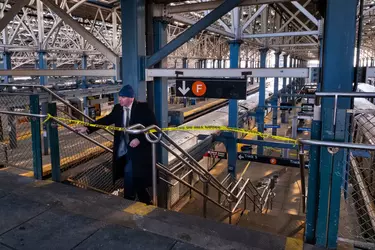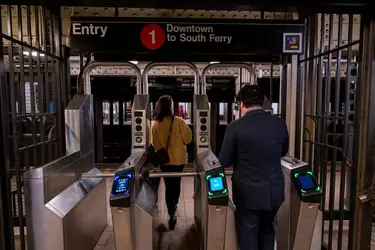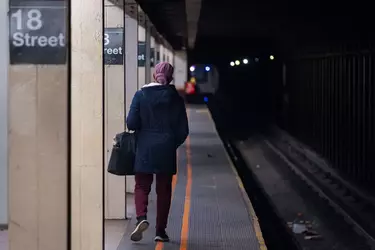A string of attacks has riders devising their own strategies to stay safe, even after years of official efforts to make New York’s vital transportation system secure.

New York police officers investigate the scene where a woman died last month after being set on fire while sleeping in a subway car. Dakota Santiago for The New York Times
By Andy Newman and Wesley Parnell
Jan. 1, 2025
A woman was set aflame in a subway car in Brooklyn the same day that a man was stabbed to death on a train in Queens. A man was shoved in front of a train in Manhattan on New Year’s Eve and fractured his skull. And on Wednesday, as the new year began, two men were stabbed 17 minutes apart in unrelated attacks at Manhattan stations.
The New York City subway system — that crucible of confined space, deadly machinery and the frequent presence of people capable of lashing out — feels more dangerous these days.
Statistics show that it may not be just a feeling. While violent crime in the subway has fluctuated in the past few years, there has been a substantial increase in key categories since before the coronavirus pandemic.
Felony assaults in the system are up 60 percent since 2019. Murders rose from three in 2019 to at least 11 in the year that just ended. In 2024, people were pushed to the tracks at least 25 times — about once every two weeks — compared with 20 times in 2019.
All this is happening after years in which the mayor and governor tried solution after solution: more police, more National Guard members, more outreach teams directing more homeless riders into shelters, as well as officers and medics who move people — sometimes by force — to hospitals if they behave erratically enough.
Elijah Encarnacion, boarding a Manhattan-bound M at the Myrtle Avenue station in Brooklyn on Wednesday afternoon has, like many riders, developed a safety routine: eyeballing other straphangers for threats, keeping his head on a swivel and knowing where he’s going.
Mr. Encarnacion, 26, a security guard and lifelong New Yorker, said his tactics kept him from feeling too vulnerable. “But with all the extra policing, you’d think people would feel safe, with all the money going into this. But I don’t think it has worked.”
To be clear, the odds of being attacked on the subway remain remote. But they are less remote than they used to be.
In 2019, the system saw 326 felony assaults through November. That works out to about one assault for every 5.2 million rides.
In 2024, there were 521 felony assaults through November. But there were also 30 percent fewer rides than in 2019. That’s about one assault for every 2.3 million rides.

Hours after a man was pushed into the path of an oncoming train on New Year’s Eve, New Yorkers rode with vigilance. Dakota Santiago for The New York Times
Marcos Soler, deputy secretary for public safety to Gov. Kathy Hochul, said on Wednesday that subway violence reflected conditions aboveground. Compared with 2019, felony assaults citywide were up more than 40 percent in 2024, and murders about 18 percent.
Still, crimes committed in the tight confines of a subway car have a special terror. Last month, a Manhattan jury acquitted Daniel Penny, a former Marine, of choking a homeless man to death after he boarded an F train and terrified riders with his ranting. Mr. Penny’s lawyers argued that he had been trying to protect his fellow riders from Jordan Neely, who had a history of mental illness.
Governor Hochul said in a statement Wednesday that a bill she was backing to make it easier to involuntarily hospitalize people in psychiatric crisis could help reduce attacks in the subways.
“We have a duty to protect the public from random acts of violence,” she said, “and the only fair and compassionate thing to do is to get people the help they need.”
On Tuesday, Mayor Eric Adams expressed frustration at the difficulty of keeping unbalanced people out of the system.
“People should not be sleeping on subways and on streets,” he said. “And we should not wait until they commit a crime like burning an innocent person or shoving someone on the subway before we say we have a problem.”
Two hours later, a 45-year-old man was standing on the platform at the 18th Street station, looking down at his phone, when a man ran up and shoved him into the path of an arriving train.
The victim, Joseph Lynskey, suffered a skull fracture, broken ribs and a ruptured spleen. The police arrested a 23-year-old, Kamel Hawkins, and charged him with attempted murder. Mr. Hawkins’s father said that his mental state had recently seemed disturbed.
A few blocks away on Wednesday morning, Haley Rohrer, 25, was walking out of the 14th Street station, where hours before, a 31-year-old man had been stabbed in the back by a person who fled. (The victim was in stable condition.)
“I’m always wondering if something bad is going to happen,” Ms. Rohrer said, “especially as a woman.” But she said that her reservations were far outweighed by the subway’s speed and convenience.
Sasha Israel, 25, on his way into the station, paused to pronounce the system a disaster.

Riders calculate risks and formulate their own strategies for staying safe underground. Dakota Santiago for The New York Times
“It’s terrible,” he said. “People are on fire, people are getting stabbed and people are getting shot.”
In the other stabbing on Sunday, a man was attacked on the platform at the 110th Street station of the 1 train in Manhattan by another man who fled. That victim was in stable condition, too.
In a November rider survey, the Metropolitan Transportation Authority found that passengers rated the subways about a 6 for safety, on a scale of 1 to 10. More than 30 percent of riders surveyed said they would need to see “fewer people behaving erratically” in order to feel safer.
Danny Pearlstein, a spokesman for the advocacy group Riders Alliance, said Wednesday that trains could be safer if some officers who monitor turnstiles for fare evaders instead focused on the platforms and trains.
The M.T.A. and the city have poured resources into stopping fare-beating, in part based on the “broken windows” theory that people who jump the turnstile are also more likely to commit more serious crime.
“That theory has been tested long enough for it to be completely debunked,” Mr. Pearlstein said. “If we’re going to have a large police presence in the subway, it should be focused on violence prevention, and the place transit riders want to see policed is on the platform and on the trains.”
On Wednesday, Cian Genaro, a 23-year-old actor, hopped off a 1 train at the same station where Mr. Lynskey was attacked. He said that since the depths of the pandemic — when ridership fell off sharply, some trains resembled homeless encampments, and people with seemingly untreated psychosis were a common sight — the subways have gotten “marginally safer.”
He said that to make the subways feel truly secure would require solving seemingly intractable social problems: homelessness, the lack of affordable housing, holes in the mental health safety net.
All the same, Mr. Genaro said, “I’m way more worried about getting in a car and driving in New Jersey than being on the subway.”
Source (Archive)
